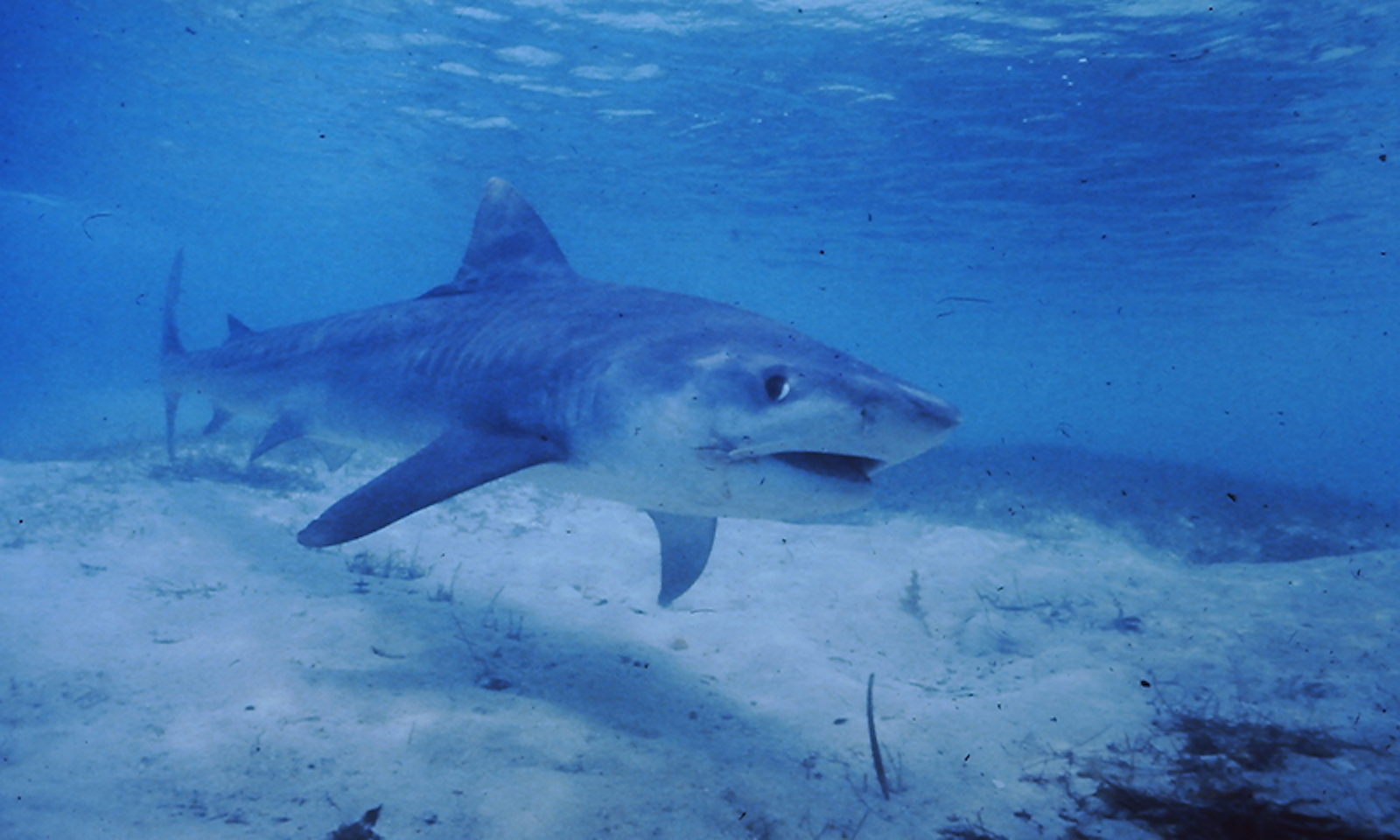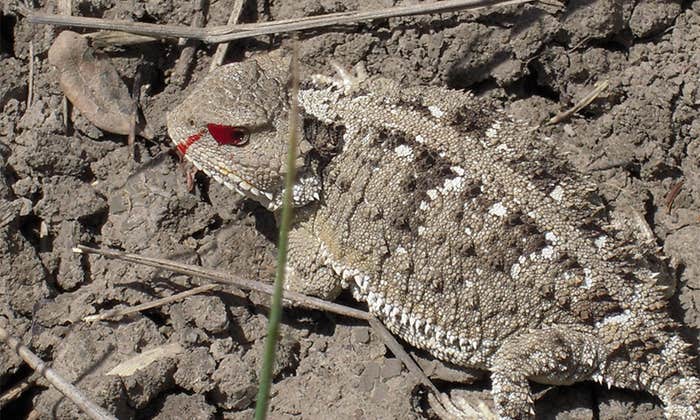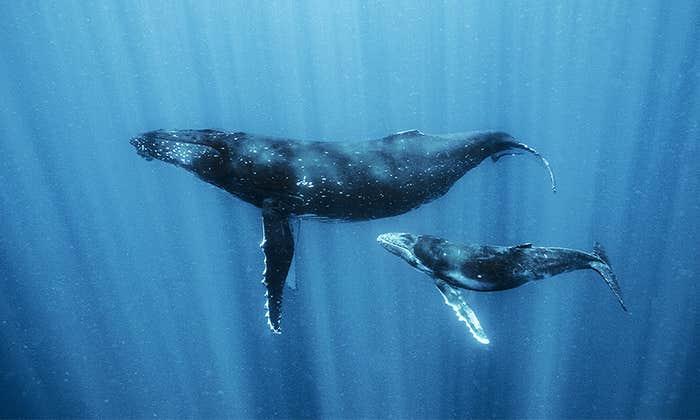In the 1970s, when a young filmmaker named Steven Spielberg was researching a new movie based on a novel about sharks, he returned to his alma mater, California State University Long Beach. The lab at Cal State Long Beach was one of the first places in the United States to study sharks in a rigorous way. Spielberg was developing a character who was a shark researcher, so he sent an art director to campus. There, the art director found the office of Donald Nelson, the unflappable biologist, spear fisherman, and shark fanatic who founded the lab in 1966. Nelson’s office was an art director’s dream, filled with maps, scientific papers, shreds of napkins with engineering plans on them, various shark repellents.
The director took every single piece of paper—all the photographs, nautical charts, scribbled notes on napkins—off the wall and made photocopies. Then he put all these pieces back in their places, one by one. He used them to build the character of Matt Hooper, the charismatic double-denim-wearing shark scientist played by Richard Dreyfuss.
The movie was, of course, a smash hit. It earned over $260 million in its initial domestic release in 1975, enough to make it the biggest moneymaker in Hollywood history to that point. It also left its mark on the reputation of sharks. The opening lines alone, backed by that daggered two-note musical score, gave a sense that sharks were a nearly demonic force: “It lives to kill. A mindless eating machine. It will attack and devour anything. It is as if God created the devil, and gave it … jaws.” David Shiffman, a marine biologist and author of Why Sharks Matter, says, “Jaws made a generation absolutely terrified of sharks.”
Nelson had an epiphany: Sharks must be attracted to sound.
Nelson was credited as a science advisor and fully supported the film, as well as its 1978 sequel, Jaws 2. But over the next two decades, as Nelson’s research career took off, he would flip the script about sharks, bringing them out of the dark realm of fevered imagination into the clear light of science. By researching shark behavior up close for the first time, and making countless documentaries that allowed people on their couches into the underwater world he loved, he began to change people’s minds. A deadly, despised predator with a face full of teeth began to seem vulnerable, even elegant, a critical choreographer of the ocean ecosystem. By the time Nelson died in 1997, sharks had become the focus of conservation programs across the planet.
Nelson was born in Plainfield, New Jersey, as an only child, near the eastern shore of New Jersey. He grew up fascinated by fishing, photography, and ornithology—when other kids were playing sports, Nelson was often looking at birds, collecting bird nests, and taking pictures. A lover of cameras and technology, as a child he had a bold ambition to photograph every living species of bird on Earth.
But the ocean tugged at him, and his ability to spearfish meant he could make a nice side income selling fish to restaurants. He got a biology degree at Rutgers University in 1958, and then moved to Florida to study biology at the Marine Laboratory of the University of Miami. It helped that Miami was the spear fishing capital of the United States at the time. Nelson joined a competitive team of spear fishers called the Glug Glugs. Aboard a 22-foot Prowler, he could spend a whole weekend catching grouper—and contributing to his education.
It was on a spear fishing trip in 1959, the story goes, that Nelson met his first shark. He had speared a small grunt—a bottom-dwelling fish known for the guttural noises it makes—and as the fish was making a racket on the seafloor, a shark darted in out of nowhere. “Here was this 4-meter tiger shark looking at Don as if he were a somewhat impaired, large, marine organism—perhaps a strange sea turtle,” recalled colleague and former graduate student Samuel Gruber in a eulogy to Nelson published in 2001. No one knew, at the time, whether such a shark might attack on the spot. Don speared it and took it home with him. “That encounter on the reefs in 1959 was both to change Don’s life and eventually much of what we know about shark behavior,” Gruber writes.
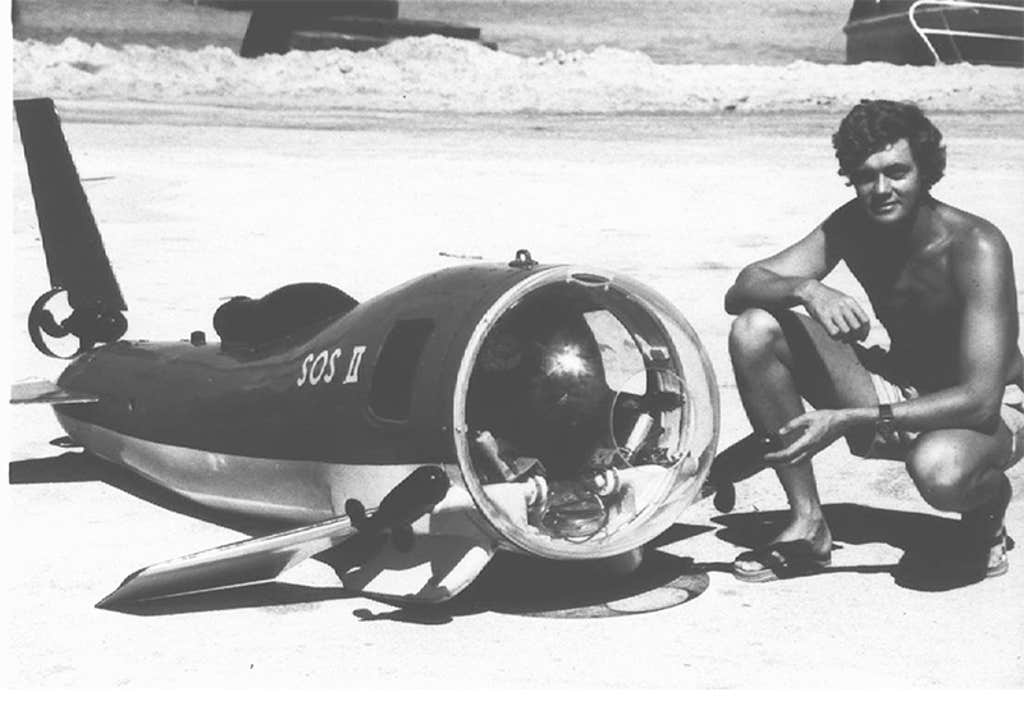
After the encounter, Nelson had an epiphany: Sharks must be attracted to sound. That insight led to one of the first studies of shark senses and behavior in the world. Together, Nelson and Gruber crafted synthetic sounds of struggling fish and recorded them on audio tape. Then they used an ultrasonic underwater speaker developed by the Navy and a tape player and set up field tests with quiet, control periods.
In the initial playback series, a total of 22 sharks came to investigate their phony fish sounds. The sharks only appeared when they were playing the recordings, not when it was quiet. The results suggested that sharks were attracted over potentially long distances to pulsed low-frequency vibrations like those emitted by wounded fish—or thrashing swimmers. Though the duo were still just graduate students at the time and their research had never appeared in a scientific journal before, the findings were published in Science in 1963.
Sharks are notoriously difficult to study. They live in the murk, tend to shy away from divers, and travel constantly. Too large to keep in the lab, and difficult to track in the wild due to their extensive ranges and secretive natures, they weren’t the focus of rigorous study until the 1950s. As a result, much of what people knew about sharks derived from brief, spontaneous encounters out at sea—or reports and media coverage of shark attacks.
One attack in particular captured the public’s attention. In 1945, a Navy heavy cruiser called the Indianapolis sank between Guam and the Philippines, and sailors were thrown into the sea. Oceanic whitetip sharks were drawn to the scene. Over the course of the next few days, the sharks devoured sailor after sailor. Of the 1,196 men on board, only 318 survived—150 were eaten by sharks. (The event even turns up in Jaws as Quint, the shark-obsessed boat captain, is a survivor of the attacks.)
The incident is often cited as the worst shark attack in history, but it wasn’t the only attack on Navy crews. Because many naval battles during and after World War II took place in the warm tropical waters of the Pacific Ocean, as well as the temperate waters of the South Atlantic Ocean and Caribbean Sea, and because rescues at sea could often take days in the time before GPS beacons became commonplace, sharks became a significant concern for the Navy. It began funding lab research into the development of methods that could prevent attacks—with little result.
Sharks are notoriously difficult to study.
In 1965, Nelson received his Ph.D. in marine biology and was hired at Cal State Long Beach as a professor in the biology department. By that time, his work had a new focus—using his growing knowledge about shark senses to protect people from them. “U.S. military morale was so low that they were having a hard time getting sailors on ships, they were so afraid of shark attacks,” says Chris Lowe, current director of the Shark Lab at California State University, Long Beach. Nelson had a grant from the Navy for 17 years.
Nelson and his students wanted to design shark repellents that would deter but not harm sharks. They tried creating shark tasers—cattle prods that shock the shark if it came too close (the problem was, it also shocked the diver). Another project looked at surfactants—soap-like substances—that could be squirted into a shark’s mouth. Students would fill fire extinguishers with soapy water of different concentrations and go out into the Catalina channel with blue sharks. “You would hold a mackerel in your hand with one hand, and when the shark could come in you stick this hose in its mouth and give it a squirt,” says Lowe. The shark would swim away with his mouth open. “The problem was that 20 minutes later, it would turn around and come back.” Nelson’s shark repellents never panned out.
That Nelson spent years trying to develop shark repellents was ironic, because more than any marine biologist, Nelson was dedicated to getting close to sharks, observing them in their natural environments. He was completely at peace in the ocean, calm and unflappable. Nicknamed Reef by his friends, he was said to be more comfortable in the water than out. He would free dive to 60 feet deep and just swim around, peeking into the nooks and crannies of the reef. “He had zero fear of sharks,” his widow, Ginger Nelson, told me. “Zero.”
An expert free-diver, Nelson swam right up to sharks to observe their behavior. He was famous for what became known as the Kamikaze Technique. “He would simply free dive on a reef shark minding its own business and chase it along the reef face until it became rather trapped,” writes Gruber. “At that moment, the shark would either flee or begin the sinister underwater ballet Don called an ‘agonistic display.’ ” The shark would raise its snout, depress its pectoral fins, arch its back, hold its tail sideways, and swim in an exaggerated figure-eight pattern. If he continued to approach, the shark would launch a warp speed attack, lunging forward and then retreating rapidly. Nelson thought this ritualized behavior was motivated by self-defense against a perceived predator, in part because it almost never occurred in feeding contexts and did not seem to be specific to a particular home range.
But after a 1976 brush with a “rather pugnacious” shark, as Nelson called it—he ended up driving it away with his spear—he realized new techniques would be needed to study sharks up close. “With absolutely no engineering background, over dinner with his students, Don got out his pencil and on the back of a napkin, his favorite teaching device, he sketched out a design for a wet, one-man sub,” writes Gruber. He called it the SOS: Shark Observation Submersible. A variation of the SOS is still in use today.
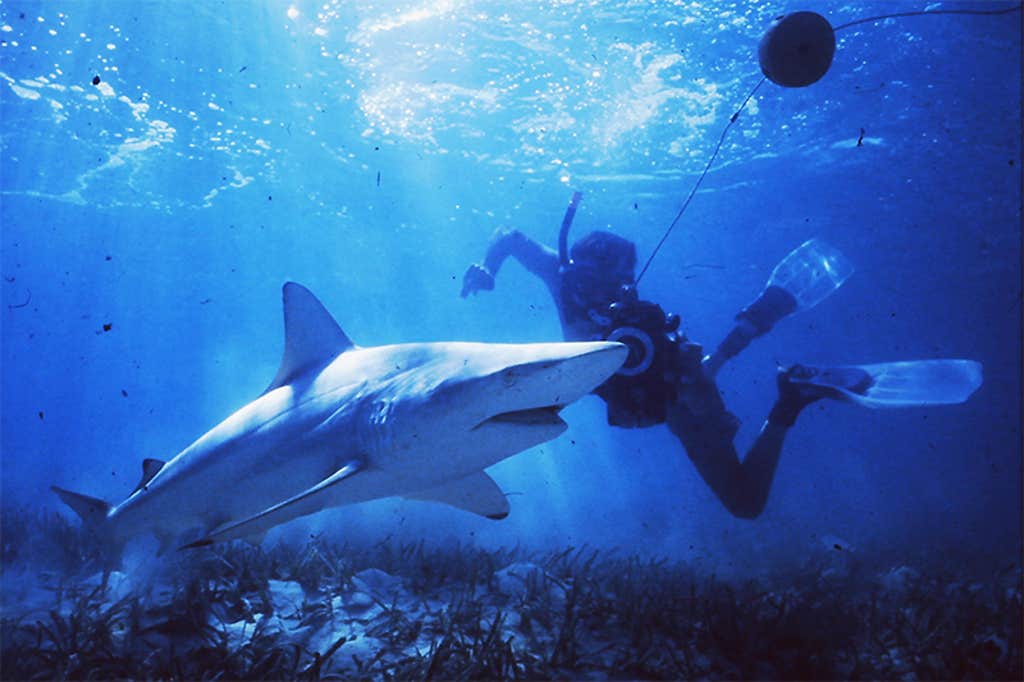
A fiberglass contraption, the SOS allowed Nelson to lie on his belly and look out on the underwater world, controlling it with fins and a small motor. Air tanks meant he could stay below the surface for more time. While he lay there in the submersible’s bed, he was multitasking. He would control the direction of his own submersible and film the shark, while another submersible filmed him chasing the animals. “Logistically, it was a nightmare to do,” Lowe says. “And dangerous as hell.” Occasionally, the batteries would die and he’d sink to the bottom, in need of rescue. Or a shark would bite the propeller off the submersible.
But the SOS had other limitations, too: The amount of time Nelson could spend tracking sharks in it was brief—and it couldn’t tell him anything about what they did or where they went under cover of darkness—at night or in the deeper waters of the ocean that the SOS couldn’t reach. So Nelson also dreamt up new acoustic transmitter technology that would allow him to track sharks and study them remotely for much longer periods of time. This same technology forms the basis for modern studies of sharks and rays.
“This occurred in the prehistoric era, before integrated circuits, lithium batteries, and well-stocked telemetry vendors,” writes Timothy Tricas, a shark researcher at the Florida Institute of Technology and former student of Nelson’s, in an essay about Nelson’s legacy. “There were even fewer biologists who could tackle the custom electronics designs needed for their research projects. Nevertheless, Don and his students (the present author included) spent countless weekends and holidays designing and soldering together ultrasonic transmitters from discrete transistors, capacitors, and resistors.”
Nelson’s lab was only the second group in the world to put an acoustic transmitter on a free-ranging shark. Transmitters—either attached to the animal or popped inside a fish that would be fed to them—opened up an entirely new world of remote shark research—following them as they moved over hundreds of miles of open ocean.
Over 30 years, Nelson’s lab produced almost 50 publications about shark behavior. His detailed field studies of large free-ranging shark species, such as the gray reef, reef whitetip, blue, angel, leopard, and megamouth sharks, took him to sites all over the world, including the Gulf of California, Marshall Islands, Polynesia, Australia, and the Bahamas. In study after study, Nelson uncovered evidence that sharks are complex and intelligent social animals, rather than the solitary, unpredictable killers driven by primitive instincts and insatiable hunger featured in Jaws.
Many shark behaviors are, in fact, extremely predictable, Nelson found. One of the most elegant examples is the agonistic display. But Nelson also found that shark feeding and migratory activity is closely tied to the rising and the setting of the sun: Though it varies somewhat from one species to the next, most sharks travel primarily after dark and feed at dawn and dusk, with some seeming to use the sun as an orientation cue. Nelson and his colleague Richard Johnson studied one species of shark in French Polynesia that is so regular in its daily movements that they were able to forecast where the sharks would appear along an established route within a matter of minutes.
Nelson swam right up to sharks to observe their behavior.
Nelson also found that many sharks are social and capable of learning: In repeated studies of sensory function, he showed they were able to “habituate” to both visual and auditory stimuli and to the presence of humans. And they make friends: A number of species travel in groups, he found, most notably the scalloped hammerhead shark, which forms daytime schools off of several islands and seamounts in the Sea of Cortez. The lemon shark also associates with its own kind, as well as with other species of sharks and rays and certain species of fish, relationships that are mutually beneficial—the shark offers protection to the fish, for example.
Overt aggression, he found, is actually unusual in sharks, outside of the gray reef shark. Few species engage in chasing or threats—either to other sharks or to humans. Even during active feeding, including infamous “feeding frenzies”—in which multiple sharks vigorously feed together over an extended period in a single area—sharks seem interested only in getting food as opposed to competing with one another. And few species exhibit territorial behavior, Nelson reported in his research.
Observing and describing shark behavior put them in the category of animals that could be understood. Nelson learned to decode their body language and create a dictionary of that language for others. Taken as a whole, his work painted a sympathetic picture of a creature that is like so many other familiar species roaming the Earth: defensive when threatened, social by nature, providing ecosystem benefits to other creatures, driven by the rhythms of the sun and the seasons.
In October 1990, the lab’s phone rang. The message: A shark considered to be a living fossil had been caught in a fisherman’s gill net off Dana Point, California. The fisherman had brought it in, alive, in the waters off the point.
Nelson was teaching a class, but everyone in the lab knew what to do. They started mobilizing a small army of researchers—armed with transmitters—to meet the shark. Nelson would drive his boat, The Discovery, to Dana Point, while others raced there in cars.
When the researchers arrived, they found a circus of action around the animal. It looked like a hippo’s head had been pasted onto an enormous fish body—15 feet long, bronze like a statue, with a wide jaw. Tied by its tail to the boat that caught it, the animal garnered gawkers from both land and sea. Jet skis zoomed in, and a helicopter circled. Some onlookers were shouting about letting the shark—dubbed Mega—go free, while others stripped off their clothes and dove into the cold waters to have the chance to swim with such a rare shark. Only five megamouths had ever been discovered, and they were all dead by the time they were caught. This was the first one caught alive.
A diver with a dart gun implanted two transmitters into the shark that would send back signals about how deep the shark dove and its location.
And then, the rope was untied and the shark disappeared into the waters of southern California. Nelson hadn’t made it with his boat yet, but the young graduate students caught a ride aboard a boat owned by Ethan Wayne, son of movie star John Wayne, and Nelson met them at sea and took over the chase.
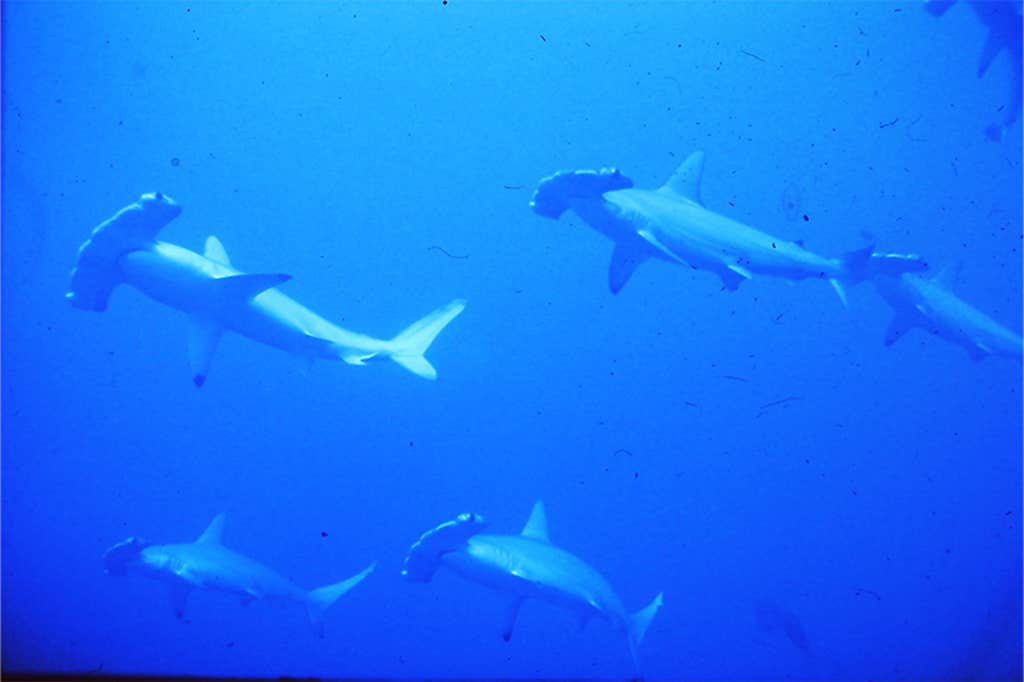
Over the course of the next three days, the team of biologists tracked the shark aboard the boat, as it zigged and zagged south and west, away from shore, sending back signals to a radio they monitored from the transmitters it carried under its skin. No one had ever seen or recorded a live megamouth before. And now, a boat was following one through its murky underwater habitat for days on end. Some of the graduate students free-dived to see if the megamouth emitted bioluminescence. The feeling on the boat was one of total elation.
“It was like walking on the moon,” recalls Jim McKibben, director of the Science Learning Center at Cal State Long Beach, then a grad student in Nelson’s lab, “doing something that nobody has ever done before.”
Nelson spent thousands of hours filming sharks and collected a massive library of 16-mm film that includes footage of the animals responding to low-frequency sounds and engaging in precisely coordinated behaviors. Between 1968 and 1994, he and his students made 25 documentaries that aired on television or made their way into school classrooms. These shows reached millions of viewers each week, and much of his footage still appears on television today—for example, Nelson’s work featured in the popular 2019 documentary Deep Blue, about the largest great white shark ever recorded.
In one of his films from the ’90s, Shark Doctors, Nelson describes preemptive efforts to protect the white shark, which scientists suspected at the time was endangered, potentially numbering in the low hundreds of individuals, despite a lack of precise population data. “It wouldn’t take much to knock that population way down and possibly risk extinction,” he tells us, as we witness on screen the gleaming jaws of a white shark clamp down on a piece of bait. Shark fishing, for their meat and fins, was already decimating many species of sharks: They were dying faster than they could reproduce.
By the time Nelson died, an international effort to conserve and protect sharks had begun. It took another decade before major protections could be put in place in the U.S.—two prohibitions of shark finning in U.S. waters were passed in 2000 and 2009. Internationally, conservation approaches are still gaining steam.
Today, the shark lab that Nelson founded at Cal State Long Beach spends about half its time on outreach efforts—to educate the beach-going public and lifeguards about sharks off California’s coastline—and about half its time on research. Attitudes are dramatically different from what they were in the ’70s. “The pendulum has swung from people thinking that sharks are so dangerous and violent, that if you dip your toe in your bathtub a shark is going to eat your whole family—to some people saying sharks are just innocent, adorable, cute puppy dogs that just need hugs and kisses and love,” Shiffman says. “We really have the full spectrum now.”
Many surfers and swimmers around the world, who continue to suffer rare, isolated attacks, talk about sharks with reverence and respect, describing themselves as visitors in the sharks’ homes. In Australia, government officials have done away with the term “attack,” instead preferring to use the term “negative encounters”—which they argue is more accurate, as a third of encounters between humans and sharks leave no injuries at all.
Nelson’s work somehow straddled both sides of the divide, first helping to stoke fear of attacks through his work in Hollywood, then encouraging us through his research and films to understand sharks as intelligent social creatures, vital partners in the Earth’s ecosystem.
In 1995, Nelson found a mole on his left forearm and showed it to his wife Ginger. “He thought it looked suspicious,” Ginger recalls. Nelson was fair skinned, had grown up with no sun protection and spent most of his days diving and swimming. So he visited his doctor, who came back with the results: nothing to worry about.
About a year later, the mole returned and Nelson went back to the doctor, who found evidence of stage four melanoma, which had already spread to his lymph nodes, Ginger says. Nelson insisted on continuing to teach and research up to a month before he died in 1997. “He just did not want to give up,” Ginger says. “He absolutely loved what he did.” ![]()
Lead photo courtesy of the Shark Lab at California State University
Prefer to listen?















